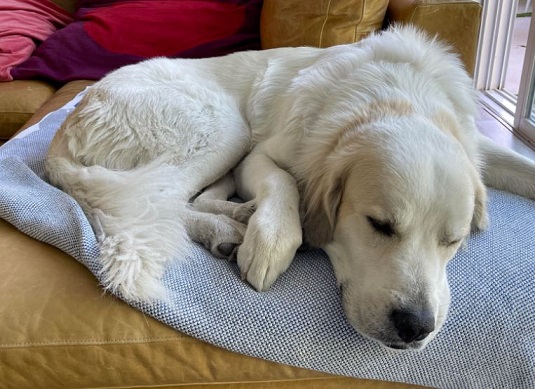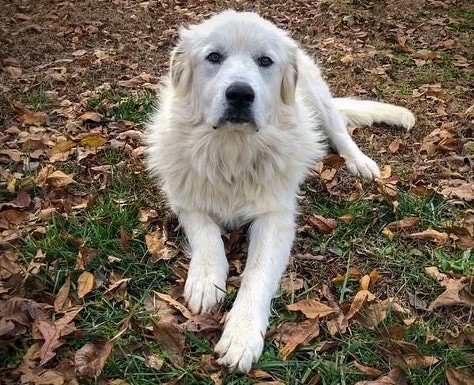A white large dog can be anybody’s dream. The Great Pyrenees or Pyrenean Mountain Dog is an attractive dog popular as both a companion and watchdog. These cuddly guard dogs are almost ideal but do they shed?
Yes, the Great Pyrenees shed a lot and so you can expect to see white hairs lying here and there. Shedding in Pyrs is more prominent during the spring season as they shed their winter coat.
While adopting the Pyrenees, you need to accept some degree of white hairs in your home. We would later discuss some tips on how you can control or manage his shedding but let’s face it. Shedding is natural and cannot be stopped!
But the good thing is they are easy to groom and are considered low maintenance.
Ever wondered what a Border Collie and Great Pyrenees look like? Read about Border Collie Great Pyrenees Mix- Size and Appearance.
Great Pyrenees Coat
Covering the Pyrenean Mountain Dog is a double-coat of medium length. This coat is pure white, soft, warm, and protective. The hairs are fine and display a cotton wool texture. The dual-layer coat consists of two layers:
Under Coat
The undercoat is the innermost hair layer. This layer of hair is the one that sheds during the summer season. The hair in this coat is insulating, water-proof, and protective. It keeps the dog warm and safe.
Top Coat
This layer of hair is mainly responsible for protection and appearance. Most dogs display a range of colors on their topcoat that is different from the undercoat.
But the Pyrenees features a single color on both layers of coat making it even harder to distinguish between the top and undercoat.
The unfortunate fact about double coats is that they are prone to shedding. Both seasonal and natural shedding is to be expected for as long as your Pyrenees lives.
Looking for a guard dog? Try the Australian Shepherd Great Pyrenees Mix.

4 Tips to control Great Pyrenees Shedding
Let us discuss some tips that can help to control and manage the Pyrenees shedding.
1. Choose the right Shampoo and Conditioner
Some harsh shampoos for dogs tend to contain harmful chemicals. In turn, these chemicals can accelerate your Pyrenees’ shedding.
When choosing bath and hygiene products for your dog, search for ones that contain organic and natural ingredients.
Some dog owners might not find this easy, it comes down to ‘trial and error’. Knowing what ingredients are harmful does help weed out the potentially dangerous dog care products.
We would recommend Oatmeal based Shampoo that has natural ingredients.
Avoid Dog Shampoos That Contain These Ingredients
Many shampoos contain substances that can be harmful to your canine. Look out for these ingredients and the effects they have on Great Pyrenees shedding.
- Isopropyl / SD- Alcohol (alcohol can dry out the skin and hair secretions)
- Mineral Oil (adding these oils can reduce or stop the release of natural oils produced by your dog)
- Artificial Fragrance/Phthalates (can disrupt the production of hormones and increase risk of getting cancer)
- Sodium Benzoate (Sodium Benzoate becomes Benzene when mixed with Ascorbic Acid / Vitamin C)
- Propylene Glycol (this compound is a suspected toxic affecting the brain, reproductive organs, skin, and immune system)
- Parabens (they have a tendency to be stored in the body and later cause reproductive issues. It can even cause cancer)
- Formaldehyde (linked to a range of skin problems- burning, itching, and blisters)
- Colorants [artificial] (these petroleum-based products can cause organ damage, allergies, or birth defects)
2. Brush Type Matters!
Using the right tools at the right time can delay or avoid a huge mess.
The right tools in this case refer to different dog brushes (grooming tools) that help to catch the dog fur before the furniture does!
Here are a few dog brushes that will go a long way in managing and reducing Great Pyrenees shedding.
Slicker Brush
The slicker brush is the number one tool used to keep Pyrenees fur looking decent and mat-free.
You will mostly find this brush very effective on dogs with long to medium hair length. The brush itself consists of short bristles distanced closely on a flat brush head.
For Pyrenees, we would recommend – Hertzko Self Cleaning Slicker Brush
Rake
A rake brush works to penetrate both layers of the Great Pyrenees coat and eliminate any tangles and potential mats. Rake brushes are shaped like a garden rake but in miniature form!
The pins on the rake brush should be carefully selected to match the length of the hair on your Pyrenees. If the pins are too long they can irritate the skin.
Pin Brush
A canine pin brush looks very similar to the brushes we humans use. It is oval-shaped with flexible bristles spaced away from each other.
Pin brushes are only useful for finishing off a grooming session or collecting hair that is already loose.
We would recommend – Coastal Pet – Safari – Plastic Wire Pin Brush
3. Balanced Diet
Diet is extremely important for keeping your dog healthy and maintaining his coat.
We recommend – Blue Buffalo Life Protection Formula
Lack of important nutrients or minerals will easily accelerate shedding. Additionally, if your dog’s skin is lacking the right nutrients it can adversely affect the coat.
Let us have a look at few of them below.
Fatty Acids
Fatty acids are responsible for that shiny glimmering hair coat. Without these compounds, your dog’s skin will become itchy and dandruff will certainly follow.
Hair would remain coarse and dry white skin can form lesions. Lesions can later become the cause of an infection.
To be precise, the compound Linoleic acid is responsible for both coat and skin health. This fatty acid exists in both animal and plant-based products.
Chicken fat, corn, and soybean oils are the best source of fatty acids. This clearly means that a Great Pyrenees diet should contain these ingredients.
They are of two types Omega-3 and Omega-6.
Omega-3
Omega-3 rich foods include flaxseed oil and fish oils. It is safe for dogs with allergies and other skin issues since it is an anti-inflammatory food.
To provide this to your dog, Omega-3 capsules are the best way to store the oils and avoid spoilage by oxidation.
Omega-6
Omega-6 is good for making hair shiny and strong. It also helps to replace and stimulate natural oils on the skin. Vegetable oils such as sunflower oil are high in this compound.
A fresh source of Omega-6 oil should be used since old ones become rancid and ineffective.
Thankfully, most dog foods are rich in Omega-6 fats.
4. Anticipate Shedding Season
As one season ends and another begins, a Great Pyrenees coat will also change to become more adaptable.
Knowing when this happens is a great help, as you can prepare for the mess! Of course, the timing of the summer and winter seasons depends on where you live.
Summer Season
Before the summer season arrives a Pyrenees Mountain dog will shed the coat to prepare. For this to happen, the thick coat will have to thin down. Yes, this process is accompanied by HEAVY SHEDDING.
Winter Season
The Great Pyrenees is known to have originated in the snow-filled mountains and their double coat helps them protected them from extreme cold.
To prepare for the winter, their thin coat is replaced by a warm thick inner coat.
Looking for a Pyrenees mix that does not shed so much? The Pyrenees Pit might be the dog you’ve been waiting for.
Types of Shedding
Shedding is natural for any dog breed, especially the Great Pyrenees which dons a long thick double coat. Longer hair means more shedding and more visible hair shed.
The Great Pyrenees shedding life cycle consists of three main types of shedding: Natural shedding, Seasonal shedding, and Other shedding. Each one is discussed below.
Natural Shedding- Year Round Shedding
Year-Round Shedding occurs to remove dead, damaged, and defective hair from the coat. This turnover assures the coat carries out its purpose and still looks good. Naturally, a dog’s coat loses hair and he replaces them with new ones.
Seasonal Shedding – Once/ Twice Yearly
An amazing process dogs use to tackle climate is seasonal shedding. Dogs can sense the change in season and shed or grow their coat in response.
The shedding during spring is quite high. It’s almost as if your dog had got a haircut to adjust for summer.
Other Shedding
Occasionally, your Pyrenean Mountain Dog will start shedding profusely for unnatural reasons. This unexpected shedding is a cause of concern and a sign of stress or illness.
The most common reasons for this shedding include:
- Stress caused by environment, other animals/humans
- Pregnancy
- Poor diet
- Disease
- Old age
In this case of shedding, finding the reason is vital. Only after correcting it, the coat may start to shed normally.
FAQS
Is it normal for Great Pyrenees to shed in clumps?
Yes, it is normal for the Great Pyrenees to shed in clumps. The coat of the Great Pyrenees is very thick. The hairs can stick together and appear to form clumps when coming out.
How do I stop my Great Pyrenees from shedding?
You don’t!
Shedding is a natural process and there is no way to completely stop shedding. Shedding helps to remove dead and broken hairs.
Great Pyrenees’ seasonal shedding is also a natural mechanism to cope with temperature changes. Failure to do so would affect the overall well-being of the dog.
When Do Great Pyrenees Shed Most?
They tend to shed average all throughout the year, except during spring when they shed their thick undercoat a lot to prepare for summer.
Do Great Pyrenees Bark Much?
The Pyrenees are known to bark loud. They are watchful of the environment and with barking, they make you aware.

